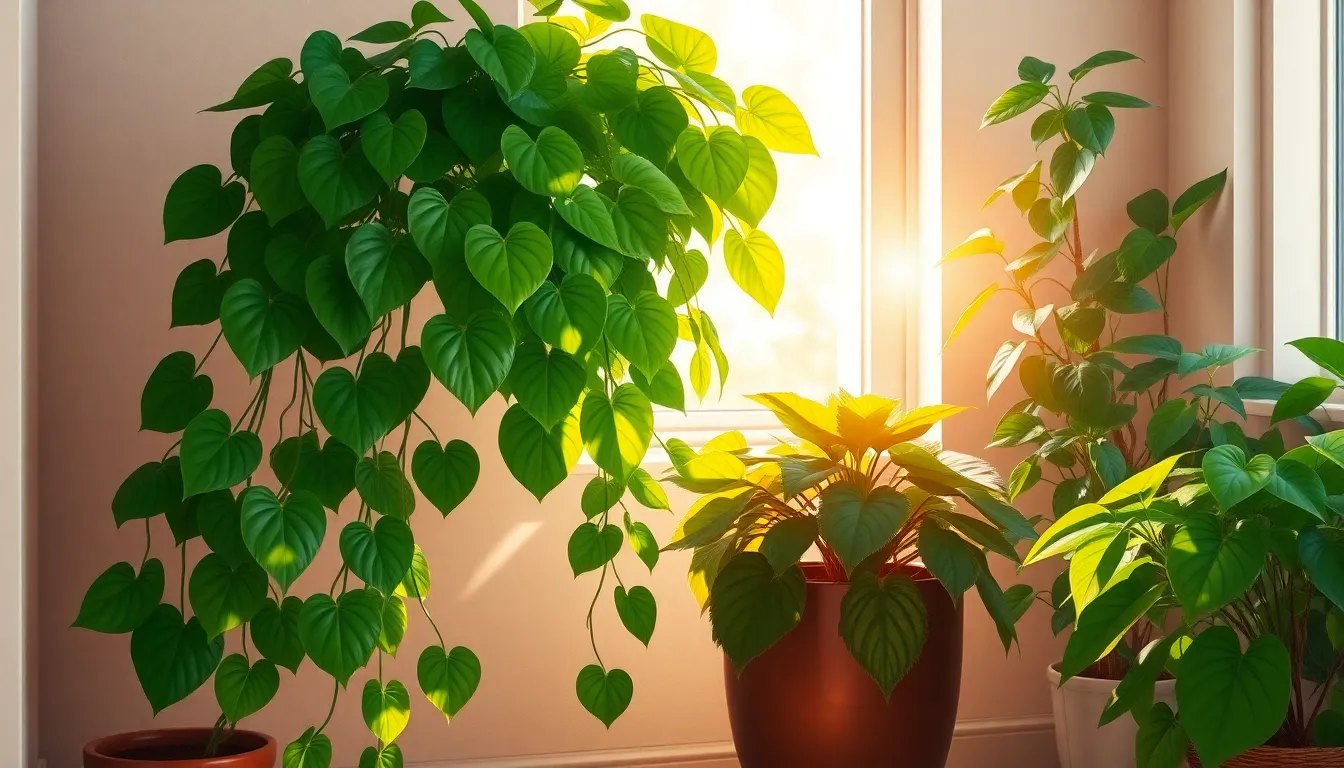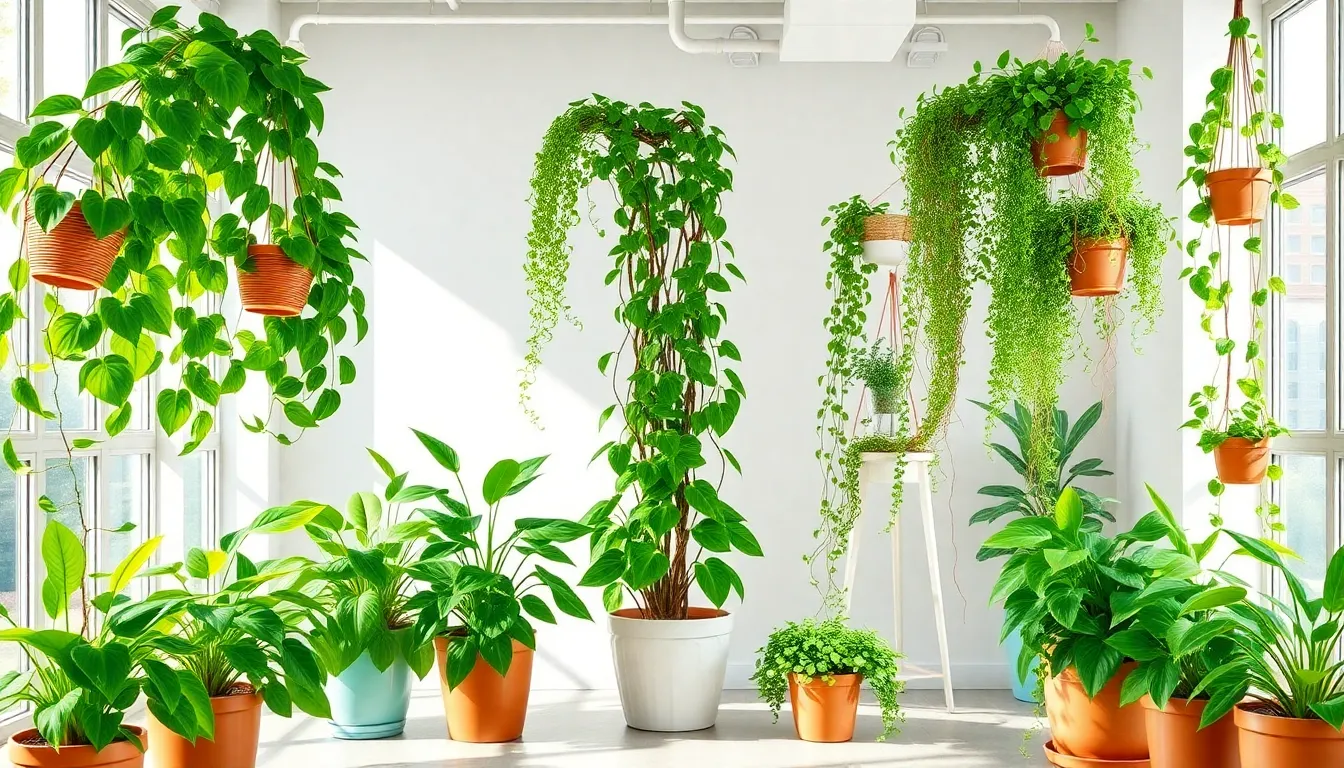Phone:
(701)814-6992
Physical address:
6296 Donnelly Plaza
Ratkeville, Bahamas.

Indoor vine plants are like the cool kids of the plant world. They twist and turn their way into our homes, adding a touch of green flair that can brighten any dull corner. But let’s face it—identifying these leafy wonders can feel like deciphering a secret code. With so many varieties out there, how’s anyone supposed to know if they’re nurturing a pothos or a philodendron?
Identifying indoor vine plants requires attention to specific characteristics. Leaf shape contributes significantly to recognition. For instance, pothos features heart-shaped leaves, while philodendron often displays broader, more varied shapes.
Color plays a role too. Varieties of pothos can showcase green, variegated, or golden hues. In contrast, philodendron can range from deep green to lighter shades.
Growth pattern impacts identification. Vining plants, such as pothos, trail dramatically and adapt to various spaces. Conversely, some philodendron species grow upright before trailing down.
Texture of leaves can provide clues for identification. Pothos leaves typically exhibit a glossy finish. Philodendron leaves present a more matte appearance, with some even having a waxy feel.
Size also varies among different indoor vine plants. Smaller pothos may reach 2-4 feet, while larger philodendron species can extend from 4-10 feet or more in optimal conditions.
Environmental preferences influence plant success. Pothos thrives in low light, making it an excellent choice for dimly lit rooms. They tolerate neglect better than philodendrons, who prefer brighter conditions for optimal growth.
Understanding these factors enhances identification skills. Observing these key characteristics leads to accurate distinctions among common indoor vine plants. Knowing specific examples equips plant enthusiasts with the tools to enrich their collections.

Indoor vines add charm and liveliness to various spaces. Identifying different types enables better care and appreciation of these plants.
Pothos ranks as one of the most popular indoor vines. Its heart-shaped leaves exhibit a glossy surface, and the plant adapts well to low light conditions. This hardy vine can grow in a range of environments, making it versatile for homes. Varieties include Golden Pothos with yellow variegation and Marble Queen with creamy white patterns. Regular watering keeps its soil slightly moist, encouraging healthy growth.
Philodendron features broader, matte leaves that beautify any space. It thrives in bright, indirect light, enhancing its growth and vibrancy. The plant’s care includes maintaining humid conditions, which it prefers. Varieties like the Heartleaf Philodendron exhibit distinct, lush foliage, while the Brasil showcases striking, multi-colored leaves. Regular watering, allowing the soil to dry slightly between intervals, promotes optimal health.
String of Hearts stands out with its delicate, heart-shaped leaves on long trailing stems. This vine enjoys bright, indirect sunlight, ensuring its vibrant growth. Its unique appearance captures the attention of many plant enthusiasts. The plant requires infrequent watering, allowing the soil to dry out completely between sessions. String of Hearts grows beautifully in hanging planters, creating a stunning visual effect.
Identifying indoor vine plants requires attention to specific characteristics. Recognizing unique traits simplifies distinguishing between different varieties.
Leaf shape varies significantly between indoor vines. Pothos exhibits heart-shaped leaves, while philodendron has broader, matte leaves. Color also plays a vital role in identification; pothos typically displays a vibrant green with golden or white variegations in certain varieties. Philodendron features deep green hues that enhance its overall appeal. Additionally, the String of Hearts showcases delicate, small leaves that resemble tiny hearts, often with silvery variegation. Observing these leaf characteristics aids in accurate identification and enhances appreciation of each plant’s beauty.
Growth habit reflects how these vines develop in indoor settings. Pothos grows rapidly, creating lush trails that can reach several feet in length. Philodendron tends to grow upward with broader leaf structures, often developing a bushier appearance. Standard sizes vary; a mature pothos plant can easily reach 10 feet, while philodendron might average around 3 to 5 feet. A String of Hearts typically trails at about 2 feet but can extend with proper care. By observing growth patterns and sizes, enthusiasts can effectively identify and cater to their indoor vine plants.
Flower characteristics present another layer for identification. Pothos rarely blooms indoors, but its flowers emerge as small spathes under optimal conditions. Philodendron, on the other hand, may produce distinctive flowers shaped like calla lilies when grown in the right environment. These blooms usually appear infrequently in indoor settings. String of Hearts can surprise with tubular pink or white flowers, adding charm to its overall aesthetic. Noticing flowering patterns adds depth to identification, aiding plant lovers in enriching their collections.
Caring for indoor vine plants requires attention to specific needs to ensure optimal growth and vitality. Understanding these requirements helps maintain lush and healthy vines.
Indoor vines thrive in various lighting conditions. Pothos enjoys low to moderate light, making it a versatile choice for dim areas. In contrast, philodendron prefers bright, indirect light to flourish, benefiting from several hours of sunlight daily. String of Hearts also appreciates bright, indirect light, which encourages growth and vibrant foliage. Positioning these plants near windows without direct sunlight helps them achieve their light needs. Blocking harsh afternoon sun with sheer curtains can prevent leaf burn while providing necessary illumination.
Watering indoor vines requires balance to avoid overwatering or underwatering. Pothos retains moisture well and typically requires watering every 1 to 2 weeks, depending on humidity and light levels. Soil should dry slightly between waterings. Philodendron, on the other hand, thrives when its soil remains slightly moist, requiring watering every week. Monitoring the top inch of soil can indicate moisture levels. String of Hearts, though drought-tolerant, benefits from watering every 2 to 3 weeks, with soil fully drying out before the next soak. Adjustments should be made based on environmental factors, ensuring each vine plant receives appropriate care.
Indoor vine plants bring a unique charm to any living space. Mastering the art of identification not only enhances appreciation but also ensures better care for these beautiful plants. By recognizing specific traits like leaf shape and growth patterns, plant enthusiasts can confidently distinguish between popular varieties.
With the right knowledge, anyone can cultivate a thriving collection of indoor vines. Embracing these tips will lead to a deeper connection with nature and a more vibrant home environment. Happy planting!